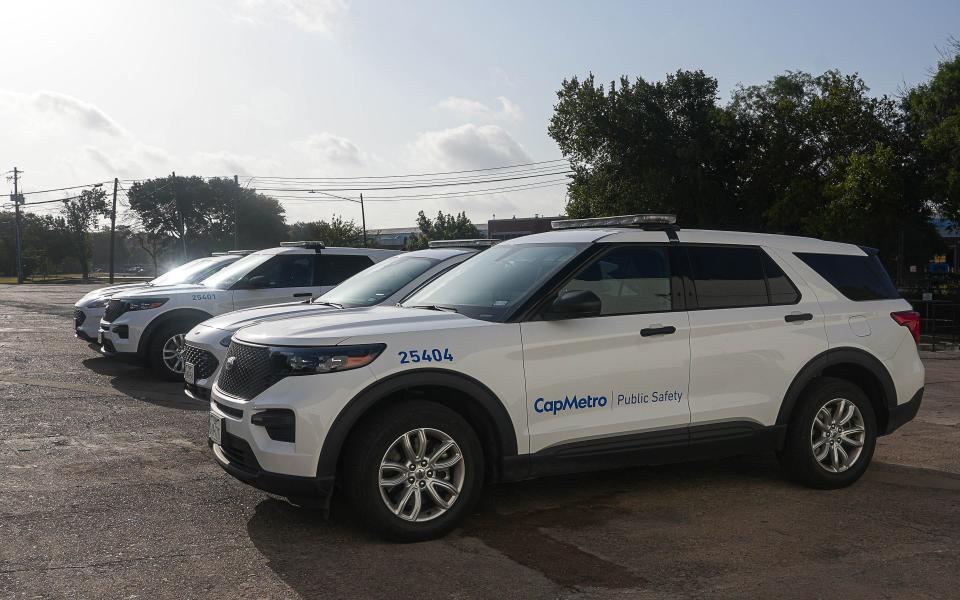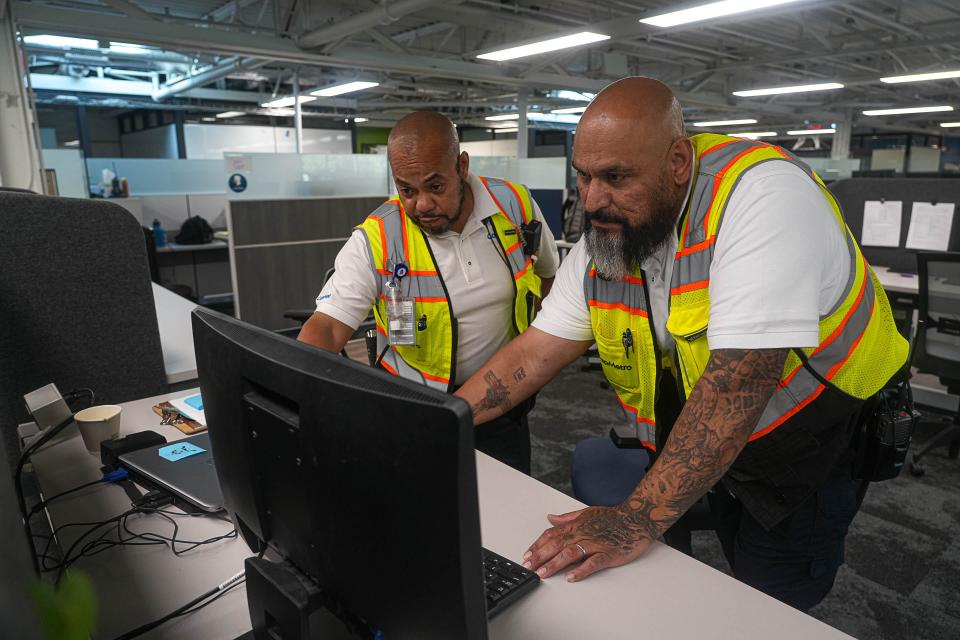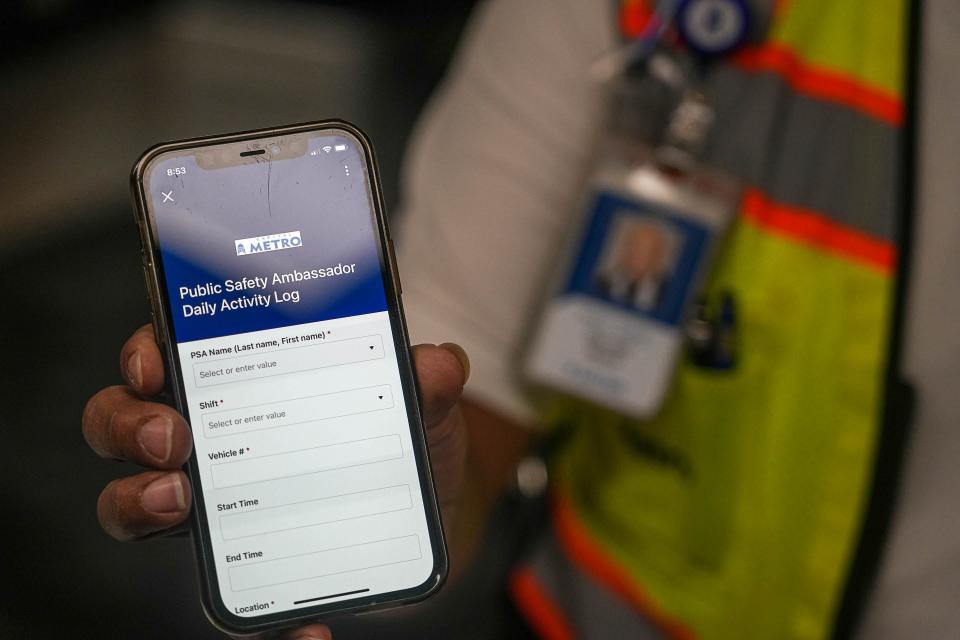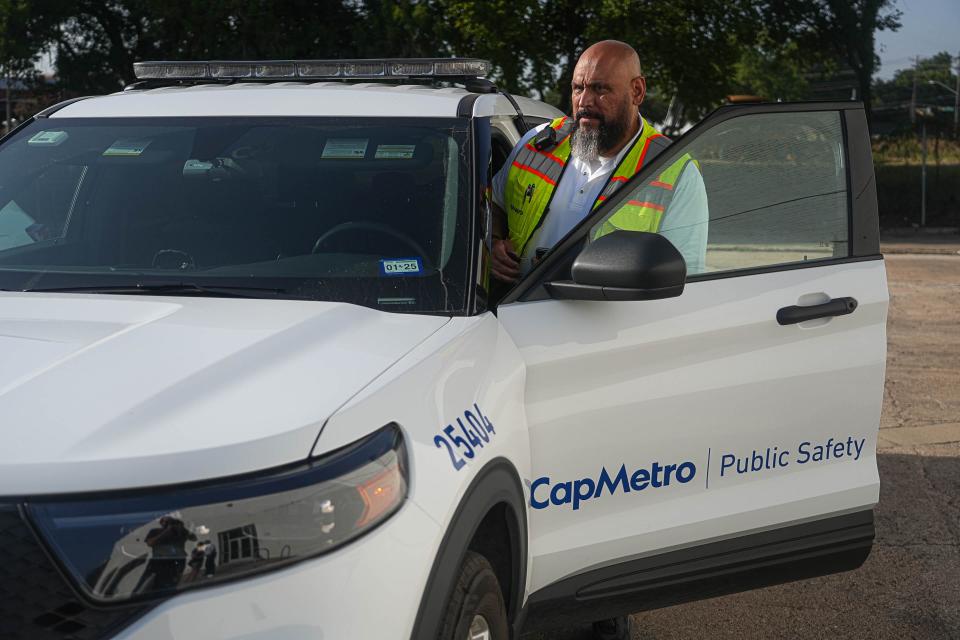CapMetro has police chief but no officers. Get a look inside of its Public Safety Program.
Usually still sporting his scrubs from work, Juan Gomez catches a Capital Metro bus in Austin most days to get home after work or class.
The 22-year-old University of Texas graduate says he has never felt unsafe while using the public transit system, but he has, at times, seen passengers he believed were intoxicated or suffering from a mental illness.
“It can be uncomfortable sometimes, but it is mostly fine,” Gomez, who works at an audiology clinic, recently told the American-Statesman while waiting at a bus stop in downtown Austin. While he understands how passengers could feel uneasy at times, any remedies, he suggested, should have a compassionate approach. “I don’t think authorities should use brute force,” he said.
Gomez’s experience echoes how public transit users responded to a survey by the Austin-area transportation authority in spring 2021, when 80% of respondents — or more than 320 users — said security while using the bus and rail systems was sufficient.
In fall 2021, CapMetro, citing the spring survey responses from its front-line workers — more than 60% of whom said security needed improvement — and a growing number of reported transit operator assaults across the country, announced its plans to roll out a three-pronged initiative: the Public Safety Program.
But in the nearly two years since the initial green light from CapMetro's board of directors, CapMetro officials could not provide a cost estimate for the largest and most expensive element of the program: creating and operating its own transit-focused police department.
CapMetro has made few hires for the new police department. A retired Houston-area police chief tapped to lead the department for an annual salary of $174,000 started in August 2022, but he has not hired any officers, in part because CapMetro has not yet sought accreditation from the Texas Commission on Law Enforcement, which certifies peace officers and law enforcement agencies across the state.
More: Amid bankruptcy filing, EV maker Proterra commits to deliver 40 buses to CapMetro
The effort to establish a CapMetro police department has drawn criticism from members of the Austin Justice Coalition worried about oversight and overpolicing, especially for the city’s homeless population and minority communities. Some transportation-focused academics suggest the funding for the department would be better used to improve the system's reliability.
Proponents say the new agency will have broad influence to develop its own culture and require training focused on mental health and de-escalation for its officers. Supporters also claim that public safety measures will be more consistent throughout the system, citing how CapMetro has relied on the availability of off-duty officers from the Austin Police Department for its patrols — an arrangement officials say has been hampered by recent staffing shortages among the city police.
CapMetro has not submitted any materials for consideration to the state law enforcement commission for its plans. Eric Robins, the former Sugar Land police chief hired by CapMetro, is aiming to earn the required accreditation for the department early next year, he said.
"I can't say it's going to happen overnight, but once (the commission) comes in, our expectation is that we will make it through," Robins told the Statesman.
The time needed to certify a new agency is "largely dependent" on the speed with which required documents are submitted, commission spokesperson Gretchen Grigsby said in a statement. Once that is done, she said, the commission typically schedules a final on-site visit within 30 days.
What is CapMetro's Public Safety Program?
CapMetro's board of directors first approved the transportation authority's Public Safety Program in August 2021.
In addition to the transit-focused police department, the program included the hiring of public safety ambassadors — unarmed, uniformed civilians trained in de-escalation tactics — and trained social workers called intervention specialists.
CapMetro currently employs three intervention specialists. Though hiring for its police department has been at a standstill, CapMetro reached its hiring goal for the public safety ambassadors, 23, last month, said CapMetro spokesperson Blythe Nebeker, who added that those staffing thresholds will not change for the foreseeable future.

Robert Grado, who served as chief of police and emergency management for the Denver-area Regional Transportation District in Colorado for five years before stepping down last winter, commended CapMetro for including the intervention specialists in its initial rollout. The equivalent for the Denver-area system proved critical, he said, because of long wait times for social workers to respond from local police departments.
"I didn't want to wait for Denver or Aurora or another city to come help us. We needed to have solutions right then and there," Grado, now a commander at the Federal Heights Police Department in Colorado, told the Statesman. "I'm glad to hear CapMetro is doing that."
More: All told, CapMetro's new HQ will cost north of $100 million. Is it worth it?
The public safety ambassadors and intervention specialists have seen broad support, though advocates say their staffing should be expanded to meet — or even exceed — what is planned for police officers. Last year, CapMetro said it planned to hire 50 police officers in the next five years.
"If this was a sort of a three-legged stool, it's the world's most unbalanced stool because you have so little investment in the interventions that are actually needed," João Paulo Connolly, organizing director with the Austin Justice Coalition, told the Statesman.

Gardner Tabon, CapMetro's chief safety officer, who oversees the program, said three intervention specialists were all they were looking to hire currently, but he said CapMetro could seek more later to "meet the need."
As for the police department, Robins said he expects to start with about 12 officers and build from there. Tabon said the transportation authority is "managing their expectations” on the 50-officer figure because of hiring challenges for police.
“The ability to hire people, more specifically law enforcement, is really not doing well, so even though we have these goals in mind, we know that there's a possibility we may not meet them when we want to meet them,” Tabon told the Statesman.
CapMetro will be the fourth transportation authority in Texas to operate a transit-focused police department. The transportation authorities in Houston and Dallas employ the most peace officers — with 232 and 198, respectively — while San Antonio has 38, according to Grigsby.
Two years into creating the program, expected cost not disclosed
CapMetro provided few financial details about the Public Safety Program. Responding to a Texas Public Information Act request for financial documents from the Statesman, CapMetro moved to seek an opinion from the Texas attorney general’s office, arguing that such records should be withheld.
However, Jacob LaBorde, a CapMetro public information coordinator, said Friday that financial documents relating to the Public Safety Program would be published on CapMetro’s website in the coming weeks.
“There are draft budget documents relating to the Public Safety Program which will be finalized within the next several weeks and posted to the financial Info page, but are not yet publicly available,” LaBorde said in an email. “As draft budget documents would likely fall under an exception to the TPIA, we are requesting an AG Opinion regarding this portion of (the Statesman’s) request.”
In their approved annual budget for fiscal 2023, CapMetro officials highlighted the allotted $8.2 million for the Public Safety and Emergency Management Department, but those funds are not broken down to show costs tied to the Public Safety Program.
More: CapMetro approves $87 million purchase for new East Austin facility
Safety concerns for CapMetro riders, drivers
When CapMetro surveyed some of its front-line workers for its spring 2021 survey, it found 63% of employees viewed security as “needing improvement" and about 30% said they felt unsafe at work.
Those sentiments have been highlighted by leadership of the union for Austin transit workers, which is in favor of CapMetro’s efforts, including its plans for the new police department.
Brent Payne, the president of Amalgamated Transit Union Local No. 1091, could not be reached for comment last week, but he told Austin NPR affiliate KUT last year, "I would want anybody who's saying it's too much police force to just understand we're out there 24/7, and when we want help, we want to be able to get it as soon as possible.”

Some riders are open to the idea. Percy Winchester, who is homeless, came to Austin a month ago from Houston, where he frequently used the region’s public transit system to get around the city. In his short time in Austin, he said, he had seen passengers “flare up” at bus drivers while using CapMetro’s services — typically while waiting at stops.
“Having bus police like Houston is a good idea,” Winchester, 59, told the Statesman.
Still, whether the presence of police will make all users feel safe is unlikely, according to Alex Karner, a UT professor whose research has included equity in transit systems. He said CapMetro should realize the presence of armed personnel on buses or at bus stops could be viewed by some as threatening.
"You're only producing safety for a certain type of rider, and you're alienating folks who are, in many cases, the core constituency of public transit; low-income people, people that don't own cars, people for whom public transit is their primary mode," Karner told the Statesman.
Last year, graduate students in Karner's class interviewed and compiled a report on transit in Austin. Among the recommendations in the 44-page report was for CapMetro to identify alternatives to traditional law enforcement, citing, in part, a possible increased risk of criminal punishment or physical harm for "minor fare or policy infractions."
Referencing the unclear financial costs of the new department, Karner said that money could instead be used to improve the system's reliability and accommodations, some of which, like ensuring there is adequate ambient lighting at bus stops, could make users feel safer.
More: $18M grant to help improve Austin's mass transit. Here's what's proposed for the Red Line.

Where will CapMetro police be stationed?
Many aspects of the planned police department appear to be fluid, including the cost and where the agency will be permanently located.
In December, CapMetro's board of directors voted to approve a 7½-year lease (with a three-year extension option) for 9,246 square feet of office space at a North Austin office complex. The full cost of the lease is $3.2 million.
Though that space, at 8200 Cameron Road, was billed as temporary at the time, Tabon said it was seen as possibly being incorporated into a larger campus later as part of CapMetro's plans with Project Connect — a transformational light rail system that would be operated by CapMetro.
However, because of the fluctuating real estate market, Tabon said those plans are being reassessed.
"We just honestly don't know, which is why we have a seven-year lease," Tabon said. "And in seven years, lots can change, so we'll leave it open."
Robins, the former Sugar Land police chief hired by CapMetro to lead its new police department, said he expects employees associated with the Public Safety Program to formally move to the Cameron Road location later this year.
This article originally appeared on Austin American-Statesman: Capital Metro's Public Safety Program has police chief but no officers

